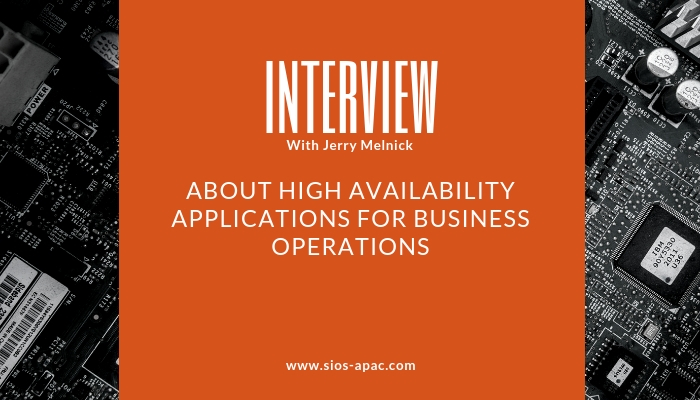About High Availability Applications For Business Operations – An Interview with Jerry Melnick
We are in conversation with Jerry Melnick, President & CEO, SIOS Technology Corp. Jerry is responsible for directing the overall corporate strategy for SIOS Technology Corp. and leading the company’s ongoing growth and expansion. He has more than 25 years of experience in the enterprise and high availability software markets. Before joining SIOS, he was CTO at Marathon Technologies where he led business and product strategy for the company’s fault tolerant solutions. His experience also includes executive positions at PPGx, Inc. and Belmont Research. There he was responsible for building a leading-edge software product and consulting business focused on supplying data warehouse and analytical tools.
Jerry began his career at Digital Equipment Corporation. He led an entrepreneurial business unit that delivered highly scalable, mission-critical database platforms to support enterprise-computing environments in the medical, financial and telecommunication markets. He holds a Bachelor of Science degree from Beloit College with graduate work in Computer Engineering and Computer Science at Boston University.
What is the SIOS Technology survey and what is the objective of the survey?
SIOS Technology Corp. with ActualTech Media conducted a survey of IT staff to understand current trends and challenges related to the general state of high availability applications in organizations of all sizes. An organization’s HA applications are generally the ones that ensure that a business remains in operation. Such systems can range from order taking systems to CRM databases to anything that keeps employees, customers, and partners working together.
We’ve learned that the news is mixed when it comes to how well high availability applications are supported.
Who responded to the survey?
For this survey, we gathered responses from 390 IT professionals and decision makers from a broad range of company sizes in the US. Respondents managed databases, infrastructure, architecture, systems, and software development as well as those in IT management roles.
What were some of the key findings uncovered in the survey results?
The following are key findings based on the survey results:
- Most (86%), but not all, organizations are operating their HA applications with some kind of clustering or high availability mechanism in place.
- A full 95% of respondents report that they have an occasional failure in the underlying HA services that support their applications.
- Ninety-eight (98%) of respondents to our survey indicated that they see either regular or occasional application performance issues.
- When such issues occur, for most organizations, it takes between three and five hours to identify the cause and correct the issue and it takes using between two and four tools to do so.
- Small companies are leading the way by going all-in on operating their HA applications in the cloud. More than half (54%) of small companies intend to be running 50% or more of their HA applications in the cloud by the end of 2018.
- For companies of all sizes, control of the application environment remains a key reason why workloads remain on premises. 60% of respondents indicating that this has played a factor in retaining one or more HA application on-premises rather than moving it into the cloud.
Tell us about the Enterprise Application Landscape. Which applications are in use most; and which might we be surprised about?
We focused on tier 1 mission critical applications, including Oracle, Microsoft SQL Server, SAP/HANA. For most organizations operating these kinds of services, they are the lifeblood. They hold the data that enables the organization to achieve its goals.
56% of respondents to our survey are operating Oracle workloads while 49% are running Microsoft SQL Server. Rounding out the survey, 28% have SAP/HANA in production. These are all clearly critical workloads in most organizations, but there are others. For this survey, we provided respondents an opportunity to tell us what, beyond these three big applications, they are operating that can be considered mission critical. Respondents that availed themselves of this response option indicate that they’re also operating various web databases, primarily from Amazon, as well as MySQL and PostgresQL databases. To a lesser extent, organizations are also operating some NoSQL services that are considered mission critical.
How often does an application performance issue affect end users?
Application performance issues are critical for organizations. 98% of respondents indicating these issues impact end users in some way ranging from daily (experienced by 18% of respondents) to just one time per year (experience by 8% of respondents) and everywhere in between. Application performance issues lead to customer dissatisfaction and can lead to lost revenue and increased expenses. But, there appears to be some disagreement around such issues depending on your perspective in the organization. Respondents holding decision maker roles have a more positive view of the performance situation than others. Only 11% of decision makers report daily performance challenges compared to around 20% of other respondents.
Is it easier to resolve cloud-based application performance issues?
Most IT pros would like to fully eliminate the potential for application performance issues that operate in a cloud environment. But the fact is that such situations can and will happen. There is a variety of tools available in the market to help IT understand and address application performance issues. IT departments have, over the years, cobbled together troubleshooting toolkits. In general, the fewer tools you need to work with to resolve a problem, the more quickly you can bring services back into full operation. That’s why it’s particularly disheartening to learn that only 19% of responses turn to a single tool to identify cloud application performance issues. This leaves 81% of respondents having to use two or more tools. But, it gets worse. 11% of respondents need to turn to five or more tools in order to identify performance issues with the cloud applications
So now we know cloud-based application performance issues can’t be totally avoided, how long until we can expect a fix?
The real test of an organization’s ability to handle such issues comes when measuring the time it takes to recover when something does go awry. 23% of respondents can typically recover in less than an hour. Fifty-six percent (56%) of respondents take somewhere between one and three hours to recover. After that 23% take 3 or more hours. This isn’t to say that these people are recovering from a complete failure somewhere. They are reacting to a performance fault somewhere in the application. And it’s one that’s serious enough to warrant attention. A goal for most organizations is to reduce the amount of time that it takes to troubleshoot problems. This will reduce the amount of time it takes to correct them.
Do future plans about moving HA applications to the cloud show stronger migration?
We requested information from respondents around their future plans as they pertain to moving additional high availability applications to the cloud. Nine percent (9%) of respondents indicate that all of their most important applications are already in the cloud. By the end of 2018, one-half of respondents expect to have more than 50% of their HA applications migrated to the cloud. While 29% say that they will have less than half of the HA applications in such locations. Finally, 12% of respondents say that they will not be moving any more HA applications to the cloud in 2018.
How would you sum up the SIOS Technology survey results?
Although this survey and report represent people’s thinking at a single point in time, there are some potentially important trends that emerge. First, it’s clear that organizations value their mission-critical applications, as they’re protecting them via clustering or other high availability technology. A second takeaway is that even with those safeguards in place, there’s more work to be done, as those apps can still suffer failures and performance issues. Companies need to look at the data and ask themselves. Therefore, if they’re doing everything they can to protect their crucial assets. You can download the report here.
Contact us if you would like to enjoy High Availability Applications in your project.
Reproduced from Tech Target




